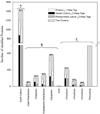Application of the accurate mass and time tag approach to the proteome analysis of sub-cellular fractions obtained from Rhodobacter sphaeroides 2.4.1. Aerobic and photosynthetic cell cultures
- PMID: 16889416
- PMCID: PMC2794423
- DOI: 10.1021/pr060050o
Application of the accurate mass and time tag approach to the proteome analysis of sub-cellular fractions obtained from Rhodobacter sphaeroides 2.4.1. Aerobic and photosynthetic cell cultures
Abstract
The high-throughput accurate mass and time (AMT) tag proteomic approach was utilized to characterize the proteomes for cytoplasm, cytoplasmic membrane, periplasm, and outer membrane fractions from aerobic and photosynthetic cultures of the gram-nagtive bacterium Rhodobacter sphaeroides 2.4.1. In addition, we analyzed the proteins within purified chromatophore fractions that house the photosynthetic apparatus from photosynthetically grown cells. In total, 8,300 peptides were identified with high confidence from at least one subcellular fraction from either cell culture. These peptides were derived from 1,514 genes or 35% percent of proteins predicted to be encoded by the genome. A significant number of these proteins were detected within a single subcellular fraction and their localization was compared to in silico predictions. However, the majority of proteins were observed in multiple subcellular fractions, and the most likely subcellular localization for these proteins was investigated using a Z-score analysis of estimated protein abundance along with clustering techniques. Good (81%) agreement was observed between the experimental results and in silico predictions. The AMT tag approach provides localization evidence for those proteins that have no predicted localization information, those annotated as putative proteins, and/or for those proteins annotated as hypothetical and conserved hypothetical.
Figures



References
-
- Woese CR, Weisburg WG, Paster BJ, Hahn CM, Tanner RS, Krieg NR, Koops HP, Harms H, Stackebrandt E. Syst. Appl. Microbiol. 1984;5:327–336. - PubMed
-
- Fang HHP, Liu H, Zhang T. Int. J. Hydrogen Energ. 2005;30:785–793.
-
- Martinezluque M, Dobao MM, Castillo F. FEMS Microbiol. Lett. 1991;83:329–334.
-
- Nepple BB, Kessi J, Bachofen R. J. Ind. Microbiol. Biotechnol. 2000;25:198–203.
Publication types
MeSH terms
Substances
Grants and funding
LinkOut - more resources
Full Text Sources

